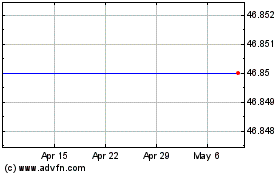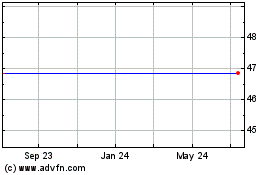(FROM THE WALL STREET JOURNAL 10/30/15)
By Georgi Kantchev and Sarah Kent
Some of the world's largest energy companies are becoming more
pessimistic about the ability of crude oil pricing to reach even
$60 a barrel next year, reporting steep losses as they take hits on
projects that no longer make financial sense.
A barrel of oil fetched more than $100 in June 2014, but a
combination of ample supply and weaker demand has driven the
international benchmark price to about $50 in the third quarter,
the lowest sustained levels since the financial crisis.
Continued oversupply means that next year, Brent crude prices
will average $58 a barrel and West Texas Intermediate, the U.S. oil
benchmark, will average $54 a barrel, according to 13 investment
banks polled by The Wall Street Journal. Many of the same banks
were predicting $70 a barrel in 2016 just a few months ago.
The analysis comes as energy titans such as Royal Dutch Shell
PLC and France's Total SA on Thursday reported billions of dollars
in write-downs after a quarter in which oil prices fell to the
lowest since the financial crisis. BP PLC earlier this week said it
had revamped its business to be cash-flow positive by 2017 at $60 a
barrel.
On Thursday, Brent crude settled at $48.80 a barrel while WTI
ended at $46.06 a barrel.
"The reality of the day is that we don't know when and how this
will balance out. We don't even know if it really stabilizes," said
Ben van Beurden, Shell's CEO, on Thursday.
While U.S. shale oil production, a driving factor in the supply
glut, has started to fall, heavyweight producers like Saudi Arabia
and Russia are still pumping at near-record levels.
Cheap energy is forcing other producers to give up on ventures
that no longer make sense with prices below $50 a barrel. On
Thursday, several oil companies reported sharply lower earnings
because of the price decline.
Shell posted a $6.1 billion third-quarter loss over its decision
to walk away from exploring the Arctic for oil and from exploiting
Canada's oil sands, which contributed to $7.9 billion in charges to
earnings.
In the U.S., ConocoPhillips reported a loss of $1.1 billion and
announced new plans to trim spending.
Petro China Co., the biggest oil-and-gas producer by volume in
China, said its third-quarter profit fell by more than 80%. At
Total, the French oil giant, the decline was 69% and partly the
result of a $650 million write-down in its Canada oil-sands
ventures.
Italy's Eni SpA experienced a loss of 952 million euros in the
third quarter and decided to sell 12.5% of its troubled oil-field
services company Saipem SpA.
Shell's about-face is among the industry's starkest. The
U.K.-Dutch giant had appeared optimistic about the future direction
of oil prices, moving aggressively earlier this year to buy BG
Group PLC for $70 billion.
Now, Shell is looking at about $55 a barrel as the break-even
price for new projects and took billions of dollars in impairment
charges after lowering its long-term oil and gas price outlook.
"Prices need to stay low in order to balance the market," said
Michael Wittner, global head of oil research at Societe
Generale.
U.S. production has started to tail off as low prices force
drillers to shut rigs and shelve costly projects.
According to the U.S. Energy Information Administration, the
nation's output peaked in April at 9.6 million barrels a day and
since has fallen to around 9.1 million barrels.
Other major suppliers, including the Organization of the
Petroleum Exporting Countries have kept producing at a high pace.
Iran, which holds 13% of the world's oil reserves, is expected to
ramp up oil exports when sanctions against the country are lifted.
Iran's return could add up to 500,000 barrels a day to the global
oil market by the middle of 2016, analysts say.
Meantime, a string of weak economic readings in China has fueled
fears about a slowdown in the world's second largest economy, which
could spill over to other markets.
The extent of the crude prices' effect on the oil industry will
come into sharper focus on Friday when American giants like Exxon
Mobil Corp. and Chevron Corp. reveal their third-quarter
earnings.
"These things take at least two years to shake off," said
Michael Hulme, manager of the Carmignac Portfolio Commodities Fund,
which manages $560 million.
---
Eric Sylvers and Inti Landauro contributed to this article.
Access Investor Kit for "Royal Dutch Shell PLC"
Visit
http://www.companyspotlight.com/partner?cp_code=P479&isin=GB00B03MLX29
Access Investor Kit for "Royal Dutch Shell PLC"
Visit
http://www.companyspotlight.com/partner?cp_code=P479&isin=GB00B03MM408
Access Investor Kit for "Royal Dutch Shell PLC"
Visit
http://www.companyspotlight.com/partner?cp_code=P479&isin=US7802591070
Access Investor Kit for "Royal Dutch Shell PLC"
Visit
http://www.companyspotlight.com/partner?cp_code=P479&isin=US7802592060
Subscribe to WSJ: http://online.wsj.com?mod=djnwires
(END) Dow Jones Newswires
October 29, 2015 20:00 ET (00:00 GMT)
Copyright (c) 2015 Dow Jones & Company, Inc.
Petrochina (NYSE:PTR)
Historical Stock Chart
From Mar 2024 to Apr 2024

Petrochina (NYSE:PTR)
Historical Stock Chart
From Apr 2023 to Apr 2024
